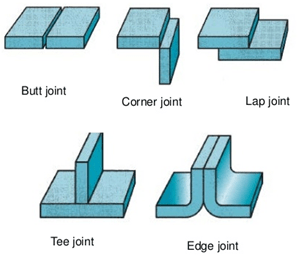This set of tough Manufacturing Engineering Questions & Answers focuses on “Welding Basics-2”.
1. Which of the following process involves metallurgical fusion?
a) Forming
b) Welding
c) Forging
d) Extrusion
View Answer
Explanation: Welding joins metals by melting and fusing them together, typically with the addition of a welding filler metal.
2. In welding, two parts are joined by bringing them to a temperature of?
a) Above melting point temperature
b) Below melting point temperature
c) Equal to melting point temperature
d) Equal to Curie temperature
View Answer
Explanation: In welding one needs to melt the base metals to fuse them.
3. In welding the strength of the joint piece could be?
a) Equal to that of parent metal
b) Greater than that of parent metal
c) Equal or Greater than that of parent metal
d) Is lesser than the parent metal
View Answer
Explanation: The strength of perfectly welded joint is more than the parent metal, due to the formation of alloy. The alloy formation at the welded portion makes it the strongest portion while the nearby zones where uncontrolled cooling take place because of heat is the weakest zone (heat affected zone). In general we can say that on the basis of strength: welded portion > parent material > heat affected zone.
4. Which of the following is a type of welding joint?
a) Tee joint
b) Lap joint
c) Corner joint
d) All of the Mentioned
View Answer
Explanation:Different types of welding joints are depicted below:

5. The oil substances are removed from the interface by using which of the following organic solvent?
a) Acetone
b) Carbon tetrachloride
c) Acetone & Carbon tetrachloride
d) Ethylene glycol
View Answer
Explanation: Both acetone and carbon tetrachloride are used to remove the oil substances from the interface.
6. Which of the following does not require fluxes to eliminate the oxides present in them?
a) Mild steel
b) Copper
c) Aluminium
d) Magnesium
View Answer
Explanation: Mild steel does not require flux to eliminate the oxides, due to the fact that iron oxide has relatively low melting point when compared to other non-ferrous metals given.
7. The heavier oxide films are removed by using?
a) Basic flux
b) Emery
c) Organic solvents
d) Neutral flux
View Answer
Explanation: Oxide films should be removed before welding. Heavier oxide films may be removed by acid pickling, emery or by wire brusing.
8. In which of the following welding process no filler material is added during joining?
a) Autogenous
b) Homogenous
c) Heterogenous
d) Either homogenous or heterogenous
View Answer
Explanation: In autogenous welding process no filler material is added during joining, the filler material can be supplied by melting the base metal.
9. Which of the following is a type of autogenous welding?
a) Arc
b) Gas
c) Brazing
d) Resistance
View Answer
Explanation: Resistance welding is inherently autogenous as there is no convenient way to apply a filler material.
10. In which of the following joining process, the filler material used is the same as the parent material?
a) Autogenous
b) Homogenous
c) Heterogenous
d) Either homogenous or heterogenous
View Answer
Explanation: In homogenous joining process the filler material used is the same as the parent material.
11. In which of the following joining process the filler material used is different as the parent material?
a) Autogenous
b) Homogenous
c) Heterogenous
d) Either homogenous or heterogenous
View Answer
Explanation: In heterogenous joining process the filler material used is different as the parent material.
12. Which of the following is a type of homogenous welding?
a) Gas
b) Solid phase
c) Brazing
d) Resistance
View Answer
Explanation: Gas metal arc welding (GMAW), manual metal arc welding (MMAW), flux cored arc welding (FCAW), etc. always use consumable filler material and thus can be performed in homogenous mode.
13. Which of the following is a type of heterogeneous welding?
a) Gas
b) Solid phase
c) Arc
d) Soldering
View Answer
Explanation: Certain welding processes such as plasma arc welding, friction stir welding, laser beam welding, etc. can be performed in heterogenous mode.
14. When two insoluble materials such as iron and silver are supposed to join, which of the following joining process is used?
a) Autogenous
b) Homogenous
c) Heterogenous
d) Either homogenous or heterogenous
View Answer
Explanation: When two insoluble materials such as iron and silver are joined then heterogenous joining process is used.
15. For joining two insoluble materials such as iron and silver which of the following filler material is used?
a) Cobalt
b) Tin
c) Aluminium
d) Zinc
View Answer
Explanation: Tin is used for joining two insoluble materials such as iron and silver because it is soluble in both the parent material (i.e. silver and iron).
Sanfoundry Global Education & Learning Series – Manufacturing Engineering.
To practice tough questions and answers on all areas of Manufacturing Engineering, here is complete set of 1000+ Multiple Choice Questions and Answers.
If you find a mistake in question / option / answer, kindly take a screenshot and email to [email protected]
- Check Mechanical Engineering Books
- Apply for Mechanical Engineering Internship
- Check Metallurgical Engineering Books
- Apply for Metallurgical Engineering Internship
- Practice Mechanical Engineering MCQs
